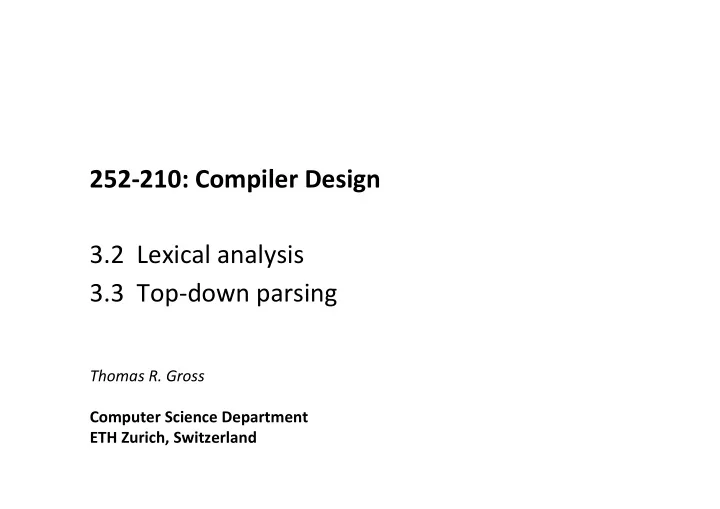

252-‑210: ¡Compiler ¡Design ¡ ¡ 3.2 ¡ ¡Lexical ¡analysis ¡ 3.3 ¡ ¡Top-‑down ¡parsing ¡ Thomas ¡R. ¡Gross ¡ ¡ Computer ¡Science ¡Department ¡ ETH ¡Zurich, ¡Switzerland ¡
3.0 ¡Frontend ¡ § 3.1 ¡IntroducFon ¡ § 3.2 ¡Lexical ¡analysis ¡ ¡ § 3.3 ¡“Top ¡down” ¡parsing ¡ § 3.4 ¡“BoNom ¡up” ¡parsing ¡ 2 ¡
Outline ¡ § Using ¡mulFple ¡grammars ¡to ¡save ¡work ¡ § Use ¡in ¡compiler ¡front ¡end ¡ § Top-‑down ¡parsing ¡ § Simple ¡(backtracking) ¡parsers ¡ § Simple ¡(predic@ve) ¡parsers ¡ ¡ 3 ¡
Comments ¡and ¡whitespace ¡ § Some ¡languages ¡aNach ¡meaning ¡to ¡whitespace ¡ § Nes@ng ¡level ¡in ¡Python ¡ § “make” ¡u@lity ¡ § Extreme: ¡Whitespace ¡programming ¡language ¡ § Only ¡space, ¡tab, ¡newline ¡ma\er ¡ § Warning: ¡macro ¡facili@es, ¡pragma ¡ § Not ¡all ¡comments ¡are ¡whitespace ¡ § Direc@ves ¡hidden ¡in ¡comments ¡ § Example: ¡Fortran90 ¡comment ¡start ¡with ¡“!” ¡ !DEC$ IVDEP – ¡ignore ¡vector ¡dependencies DO I=1, N A(INDARR(I)) = A(INDARR(I)) + B(I) END DO 7 ¡
3.0 ¡Frontend ¡ § 3.1 ¡IntroducFon ¡ § 3.2 ¡Lexical ¡analysis ¡ ¡ § 3.3 ¡“Top ¡down” ¡parsing ¡ § 3.4 ¡“BoNom ¡up” ¡parsing ¡ 13 ¡
3.3 ¡“Top ¡down” ¡parsing ¡ § Given ¡w ¡ ∈ ¡T* ¡and ¡context ¡free ¡grammar ¡G ¡(S, ¡T, ¡NT, ¡P). ¡ ¡ ¡ ¡ ¡ ¡ ¡ ¡Is ¡w ¡ ∈ ¡L(G)? ¡ § Top-‑down: ¡find ¡a ¡derivaFon ¡S ¡ ⇒ ¡… ¡ ⇒ ¡w ¡ § Want ¡to ¡find ¡a ¡lee-‑most ¡deriva@on ¡ § Process ¡input ¡from ¡lee-‑to-‑right ¡ § Languages ¡described ¡by ¡a ¡context-‑free ¡grammar ¡can ¡be ¡ recognized ¡by ¡a ¡stack ¡machine. ¡ § w ¡recognized ¡ ¡ ⇔ ¡w ¡ ∈ ¡L(G) ¡ § Get ¡deriva@on ¡for ¡free ¡(sequence ¡of ¡ac@ons ¡by ¡stack ¡machine) ¡ 16 ¡
AcFons ¡ § Error ¡ § Accept ¡ § Push ¡onto ¡stack ¡ § Remove ¡from ¡input, ¡advance ¡read ¡pointer ¡ § ReducFon ¡ § Use ¡produc@on ¡to ¡expand/contract ¡the ¡top ¡of ¡the ¡stack ¡ 19 ¡
Parser ¡decisions ¡ § Parser ¡must ¡decide ¡based ¡on ¡ top ¡of ¡stack ¡and ¡current ¡input ¡ § Current ¡input ¡ § Either ¡the ¡next ¡token ¡ § Some ¡number ¡ k ¡ of ¡remaining ¡tokens ¡ 20 ¡
Trivial ¡grammar ¡ S ¡ � ¡Id ¡Op ¡Id ¡| ¡ ¡(1) ¡ ¡ ¡ ¡ ¡ ¡ ¡ ¡ ¡ ¡-‑ ¡Id ¡ ¡ ¡ ¡ ¡ ¡ ¡(2) ¡ Op ¡ � ¡+ ¡| ¡ ¡ ¡(3) ¡ ¡ ¡ ¡ ¡ ¡ ¡ ¡ ¡ ¡ ¡ ¡ ¡ ¡-‑ ¡| ¡ ¡ ¡(4) ¡ ¡ ¡ ¡ ¡ ¡ ¡ ¡ ¡ ¡ ¡ ¡ ¡* ¡| ¡ ¡(5) ¡ ¡ ¡ ¡ ¡ ¡ ¡ ¡ ¡ ¡ ¡ ¡ ¡ ¡/ ¡ ¡(6) ¡ § Start ¡symbol ¡S ¡ § Terminals ¡: ¡{ ¡Id, ¡+, ¡-‑, ¡*, ¡/ ¡} ¡ ¡ § Non-‑terminals: ¡{S, ¡Op} ¡ 21 ¡
Parser ¡decisions ¡ § Parser ¡must ¡decide ¡based ¡on ¡ top ¡of ¡stack ¡and ¡current ¡input ¡ § Current ¡input ¡ § Either ¡the ¡next ¡token ¡ § Some ¡number ¡ k ¡ of ¡remaining ¡tokens ¡ § How ¡can ¡control ¡the ¡parser? ¡ § Must ¡be ¡sure ¡that ¡w ¡ ∉ ¡L(G) ¡if ¡we ¡say ¡there ¡is ¡no ¡deriva@on. ¡ 23 ¡
Grammars ¡& ¡words ¡ § Words ¡are ¡finite ¡ § Grammars ¡are ¡finite ¡ § Finite ¡alphabets ¡ § Finite ¡number ¡of ¡produc@ons ¡ § Try ¡un@l ¡you ¡succeed ¡ ¡ 24 ¡
Backtracking ¡ ¡ § Accept ¡if ¡stack ¡is ¡empty ¡and ¡all ¡input ¡ ¡consumed ¡ § Reject ¡if ¡there ¡are ¡no ¡more ¡choices ¡to ¡try ¡ § ImplementaFon ¡easy ¡ § May ¡not ¡be ¡efficient ¡– ¡but ¡fast ¡enough ¡in ¡some ¡serngs ¡ § Can ¡be ¡used ¡for ¡ any ¡ grammar ¡ 26 ¡
§ Not ¡all ¡grammars ¡can ¡be ¡handled ¡with ¡ k ¡ ¡symbols ¡of ¡ lookahead ¡ § For ¡any ¡finite ¡(fixed) ¡ k ¡ § What ¡if ¡we ¡allow ¡infinite ¡lookahead? ¡ 32 ¡
3.3.3 ¡ConstrucFon ¡of ¡predicFve ¡parsers ¡ § Top-‑down ¡ § PredicFve: ¡ ¡for ¡any ¡combinaFon ¡of ¡(top-‑of-‑stack, ¡input) ¡ parser ¡knows ¡how ¡to ¡move ¡forward ¡ § Towards ¡an ¡“accept” ¡or ¡“reject” ¡decision ¡ § Look ¡again ¡at ¡stack ¡machine ¡ § Prepara@on ¡for ¡Assignment ¡2 ¡ § Key ¡concepts ¡apply ¡to ¡bo\om-‑up ¡parsing ¡ 41 ¡
43 ¡
Parsing ¡table ¡M ¡ § Controls ¡operaFon ¡of ¡parsing ¡engine ¡ ¡ 1) ¡OperaFon ¡ 2) ¡How ¡to ¡set ¡M ¡ § Assume ¡context-‑free ¡grammar ¡G ¡(S, ¡T, ¡NT, ¡P) ¡ § Add ¡$ ¡to ¡mark ¡boNom ¡of ¡stack, ¡end ¡of ¡input ¡ § Goal: ¡find ¡let-‑most ¡derivaFon ¡ 44 ¡
Parsing ¡engine ¡ repeat ¡ ¡{ ¡ X ¡= ¡top ¡of ¡stack ¡ a: ¡terminal ¡pointed ¡to ¡by ¡ip ¡(input ¡pointer) ¡ if ¡( ¡X ¡ ∈ ¡T) ¡{ ¡ if ¡( ¡X ¡== ¡a ¡) ¡ ¡{ ¡pop ¡X; ¡ip++ ¡} ¡ else ¡ error() ; ¡ ¡} ¡ else ¡if ¡( ¡M[X, ¡a] ¡is ¡error-‑entry) ¡ error() ; ¡ else ¡if ¡( ¡M=[X, ¡a] ¡= ¡X ¡ à ¡Y 1 ¡Y 2 ¡… ¡Y n ) ¡{ ¡ pop ¡stack ¡ push ¡Y n ¡ … ¡Y 2 ¡ Y 1 ¡onto ¡the ¡stack ¡ record ¡produc@on ¡ ¡X ¡ à ¡Y 1 ¡Y 2 ¡… ¡Y n ) ¡ } ¡ unFl ¡(X ¡== ¡$); ¡ 45 ¡
Recommend
More recommend